Study on Safety Control of Composite Roof in Deep Roadway Based on Energy Balance Theory
Abstract
:1. Introduction
2. Energy Dissipation Characteristics of Coal-Rock Structure in the Process of Loading
2.1. Sample Preparation and Experimental Method
2.2. Mechanical Properties of Coal-Rock Structures
2.3. Energy Analysis and Energy Dissipation Law of Typical Samples in the Loading Process
2.3.1. Energy Analysis of Coal Samples in the Loading Process
2.3.2. The Energy Dissipation Law during the Failure of Typical Samples
3. Support Design Principle
4. Case Study
4.1. Geological and Engineering Conditions
4.2. Support Method and Monitoring Method
4.3. Variation Law of the Anchorage Force
4.3.1. Monitoring Results and Analysis of the Anchorage Force of the Cable in VR 21204
4.3.2. Monitoring Results and Analysis of Anchorage Force of Cable in HR 21205
4.3.3. Monitoring Results and Analysis of the Anchorage Force of the Cable in HR 3108
4.4. Discussion
5. Conclusions
- (1)
- The loading experiments on the coal-rock structures with different height ratios indicate that the strength of the coal-rock structure falls in between that of pure rock mass and pure coal mass; the strength of samples is determined by the coal-rock height ratio. When the height of the rock mass exceeds that of the coal mass, the sample strength is close to that of the rock mass, and vice versa.
- (2)
- As the load increases, the pure rock mass, pure coal mass, and coal-rock structures display different energy dissipation laws. During the pre-peak stage, the energy evolution is mainly based on the elastic strain energy. The change rule of elastic strain energy is determined by the stress value of the stress-strain curve. Meanwhile, as the height of the coal mass increases, the input energy tends to drop while the proportion of elastic strain energy to the total energy amount tends to increase. The strength peak point is crucial to the whole energy evolution. Once exceeding the peak point, the elastic strain energy is released suddenly, and the dissipation energy increases sharply, causing the failure in the coal mass in most cases.
- (3)
- The support principle is put forward based on the energy balance theory in this paper. To achieve the safety control of roadways with a composite roof, two points should be considered. One, to speed up the bolt support construction. To be specific, the bolt support should be carried out before the large-scale energy release by the surrounding rock releases. Two, to improve the strength of the support system so as to restore the initial energy balance of the surrounding rock.
- (4)
- The above-mentioned support principle is applied to the actual roadway support design and industrial tests have been conducted. The monitoring results of the anchoring force indicate that the changing rules of the anchoring force vary remarkably when different types of composite roofs are involved. This can be attributed mainly to the different forms of energy release and the conversion of different types of composite roofs. The coal-rock composite roof would consume large quantities of energy; and as the height of the coal seam increases, more energy is to be consumed. Correspondingly, the work needed to be done by the support declines, which in turn reduces the increase of the anchoring force to adapt to the energy level of the roadway surrounding rock.
Author Contributions
Funding
Acknowledgments
Conflicts of Interest
References
- Yuan, L. Strategic thinking of simultaneous exploitation of coal and gas in deep mining. J. China Coal Soc. 2016, 41, 1–6. [Google Scholar]
- He, M.C.; Xie, H.P.; Peng, S.P.; Jiang, Y.D. Study on rock mechanics in deep mining engineering. Chin. J. Rock Mech. Eng. 2005, 24, 2803–2813. [Google Scholar]
- Kang, H.P. Support technologies for deep and complex roadways in underground coal mines: A review. Int. J. Coal Sci. Technol. 2014, 1, 261–277. [Google Scholar] [CrossRef]
- Xie, Z.Z.; Zhang, N.; Qian, D.Y.; Han, C.L.; An, Y.P.; Wang, Y. Rapid excavation and stability control of deep roadways for an underground coal mine with high production in Inner Mongolia. Sustainability 2018, 10, 1160. [Google Scholar] [CrossRef]
- Wang, Y.Y.; Abbas, T.; Xu, X.B. Application of coal mine roof rating in Chinese coal mines. Int. J. Min. Sci. Technol. 2018, 28, 491–497. [Google Scholar] [CrossRef]
- Liu, B.; Yue, Z.; Tham, L. Analytical design method for a truss-bolt system for reinforcement of fractured coal mine roofs-Illustrated with a case study. Int. J. Rock Mech. Min. Sci. 2005, 42, 195–218. [Google Scholar] [CrossRef]
- Napa-García, G.F.; Santos, R.A.; Beck, A.T.; Celestino, T.B. Improvement of analytical factor of safety estimation of falling failure mode in roof wedge stability. Int. J. Rock Mech. Min. Sci. 2018, 103, 116–122. [Google Scholar] [CrossRef]
- Young, M.; Walton, G.; Holley, E. Investigation of factors influencing roof stability at a Western U.S. longwall coal mine. Int. J. Min. Sci. Technol. 2019, 29, 139–143. [Google Scholar] [CrossRef]
- Ghasemi, E.; Ataei, M.; Shahriar, K.; Sereshki, F.; Jalali, S.E.; Ramazanzadeh, A. Assessment of roof fall risk during retreat mining in room and pillar coal mines. Int. J. Rock Mech. Min. Sci. 2012, 54, 80–89. [Google Scholar] [CrossRef]
- Ma, X.G.; He, M.C.; Wang, J.; Gao, Y.B.; Zhu, D.Y.; Liu, Y.X. Mine strata pressure characteristics and mechanisms in gob-side entry retention by roof cutting under medium-thick coal seam and compound roof conditions. Energies 2018, 11, 2539. [Google Scholar] [CrossRef]
- Guo, W.H.; Chang, Q.L.; Sun, X.K. Instability mechanism and control technology for deep-buried large-span complex roof coal roadway for the prevention of coal pollution. Ekoloji 2019, 28, 1401–1410. [Google Scholar]
- Zhang, H.Q.; Han, L.S.; Qi, Y.J.; Zhang, Y.F. Stability control mechanism and integral supporting technology of roadways with thick compound roof strata. In Proceedings of the 2nd ISRM International Young Scholars Symposium on Rock Mechanics, Beijing, China, 14–16 October 2012; pp. 709–712. [Google Scholar]
- Wang, H.W.; Xue, S.; Jiang, Y.D.; Deng, D.X.; Shi, S.Z.; Zhang, D.Q. Field investigation of a roof fall accident and large roadway deformation under geologically complex conditions in an underground coal mine. Rock Mech. Rock Eng. 2018, 51, 1863–1883. [Google Scholar] [CrossRef]
- Zhou, Z.L.; Chen, L.; Cai, X.; Shen, B.T.; Zhou, J.; Du, K. Experimental investigation of the progressive failure of multiple pillar-roof system. Rock Mech. Rock Eng. 2018, 51, 1629–1636. [Google Scholar] [CrossRef]
- Huang, W.P.; Yuan, Q.; Tan, Y.L.; Wang, J.; Liu, G.L.; Qu, G.L.; Li, C. An innovative support technology employing a concrete-filled steel tubular structure for a 1000-m-deep roadway in a high in situ stress field. Tunn. Undergr. Space Technol. 2018, 73, 26–36. [Google Scholar] [CrossRef]
- Mikhalyuk, A.V.; Zakharov, V.V. Dissipation of dynamic-loading energy in quasi-elastic deformation processes in rocks. J. Appl. Mech. Tech. Phys. 1997, 38, 312–318. [Google Scholar] [CrossRef]
- Xie, H.P.; Ju, Y.; Li, L.Y. Criteria for strength and structural failure of rocks based on energy dissipation and enegy release principles. Chin. J. Rock Mech. Eng. 2005, 24, 3003–3010. [Google Scholar]
- Steffler, E.D.; Epstein, J.S.; Conley, E.G. Energy partitioning for a crack under remote shear and compression. Int. J. Fract. 2013, 12, 563–580. [Google Scholar]
- Huang, D.; Li, Y. Conversion of strain energy in triaxial unloading tests on marble. Int. J. Rock Mech. Min. Sci. 2014, 66, 160–168. [Google Scholar] [CrossRef]
- Hua, A.Z.; You, M.Q. Rock failure due to energy release during unloading and application to underground rock burst control. Tunn. Undergr. Space Technol. 2001, 16, 241–246. [Google Scholar] [CrossRef]
- Zhao, Y.S.; Feng, Z.C.; Wan, Z.J. Least energy principle of dynamics failure of rock mass. Chin. J. Rock Mech. Eng. 2003, 22, 1781–1783. [Google Scholar]
- Bagde, G.; Petros, V. Fatigue and dynamic energy behavior of rock subjected to cyclical loading. Int. J. Rock Mech. Min. Sci. 2009, 46, 200–209. [Google Scholar] [CrossRef]
- Ferro, G. On dissipated energy density in compression for concrete. Eng. Fract. Mech. 2006, 73, 1510–1530. [Google Scholar] [CrossRef]
- Krzysztof, S. Laboratory testing of a long expansion rock bolt support for energy-absorbing applications. In Proceedings of the XVIIth Conference of PhD Students and Young Scientists, Szklarska Poreba, Poland, 31 January 2018. [Google Scholar]
- Krzysztof, S. A new design of support for burst-prone rock mass in underground ore mining. In Proceedings of the XVIIIth Conference of PhD Students and Young Scientists, Szklarska Poreba, Poland, 5 December 2018. [Google Scholar]
- Zuo, J.P.; Xie, H.P.; Meng, B.B. Experimental research on loading-unloading behavior of coal-rock combination bodies at different stress levels. Rock Soil Mech. 2011, 32, 1287–1296. [Google Scholar]
- Zuo, J.P.; Pei, J.L.; Liu, J.F.; Peng, R.D.; Liu, Y.X. Investigation on acoustic emission behavior and its time-space evolution mechanism in failure process of coal-rock combined body. Chin. J. Rock Mech. Eng. 2011, 30, 1564–1570. [Google Scholar]
- Zuo, J.P.; Xie, H.P.; Wu, A.M.; Liu, J.F. Investigation on failure mechanisms and mechanical behaviors of deep coal-rock single body combined body. Chin. J. Rock Mech. Eng. 2011, 30, 84–92. [Google Scholar]
- Chen, S.J.; Yin, D.W.; Zhang, B.L.; Ma, H.F.; Liu, X.Q. Mechanical characteristics and progressive failure mechanism of roof-coal pillar structure. Chin. J. Rock Mech. Eng. 2017, 7, 1588–1598. [Google Scholar]
- Lu, C.P. Intensity Weakening Theory for Rockburst of Compound Coal-Rock and its Application; China University of Mining and Technology: Xuzhou, China, 2008. [Google Scholar]
- Liu, J.; Wang, E.Y.; Song, D.Z.; Yang, S.L.; Niu, Y. Effects of rock strength on mechanical behavior and acoustic emission characteristics of samples composed of coal and rock. J. China Coal Soc. 2014, 39, 685–691. [Google Scholar]
- Guo, W.Y.; Zhou, H.; Xu, N.H.; Chen, W.G.; Wei, P. Simulation study of mechanical properties of coal rock combination. Saf. Coal Min. 2016, 47, 33–35. [Google Scholar]
- Gao, M.S.; Zhang, N.; Dou, L.M.; Wang, K.; Kan, J.G. Study of roadway support parameters subjected to rock burst based on energy balance theory. J. China Univ. Min. Technol. 2007, 36, 426–430. [Google Scholar]
- Zhang, J.W.; Shi, Q.; Liu, Z.J.; Li, X.W.; Zhao, J.L. Analysis of energy dissipation for stagger arrangement roadway surrounding rock. J. Min. Saf. Eng. 2015, 32, 929–935. [Google Scholar]

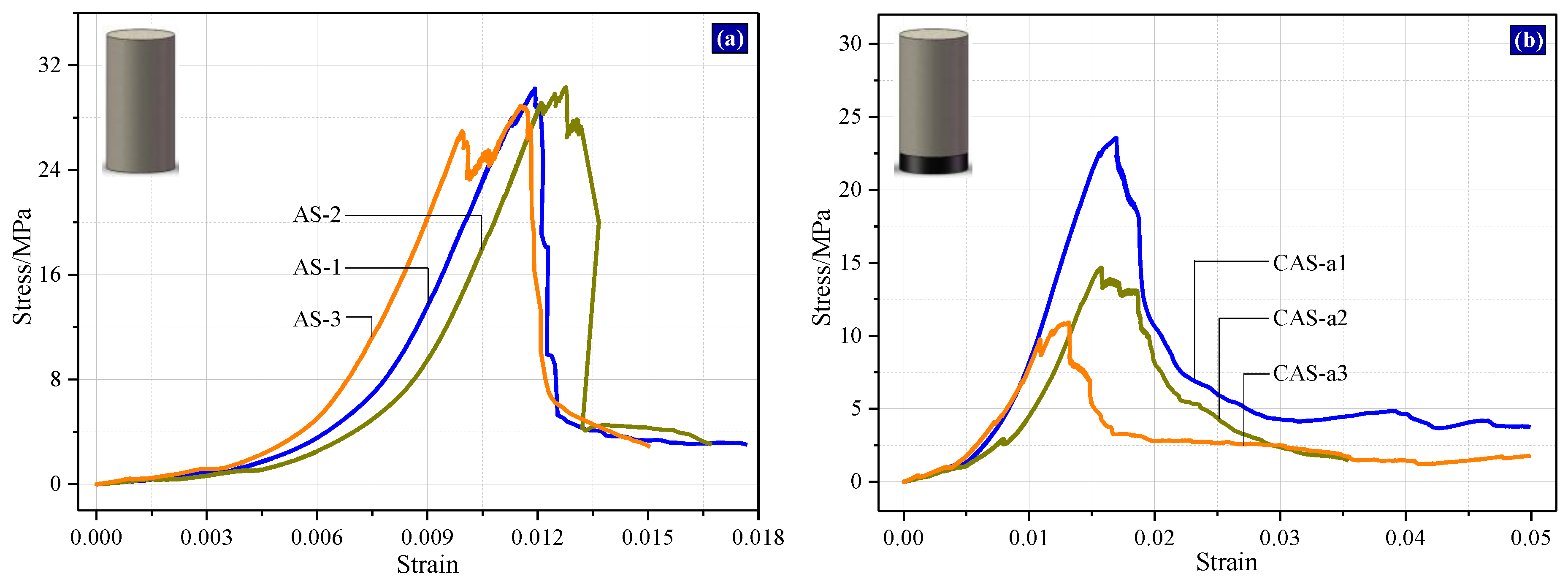

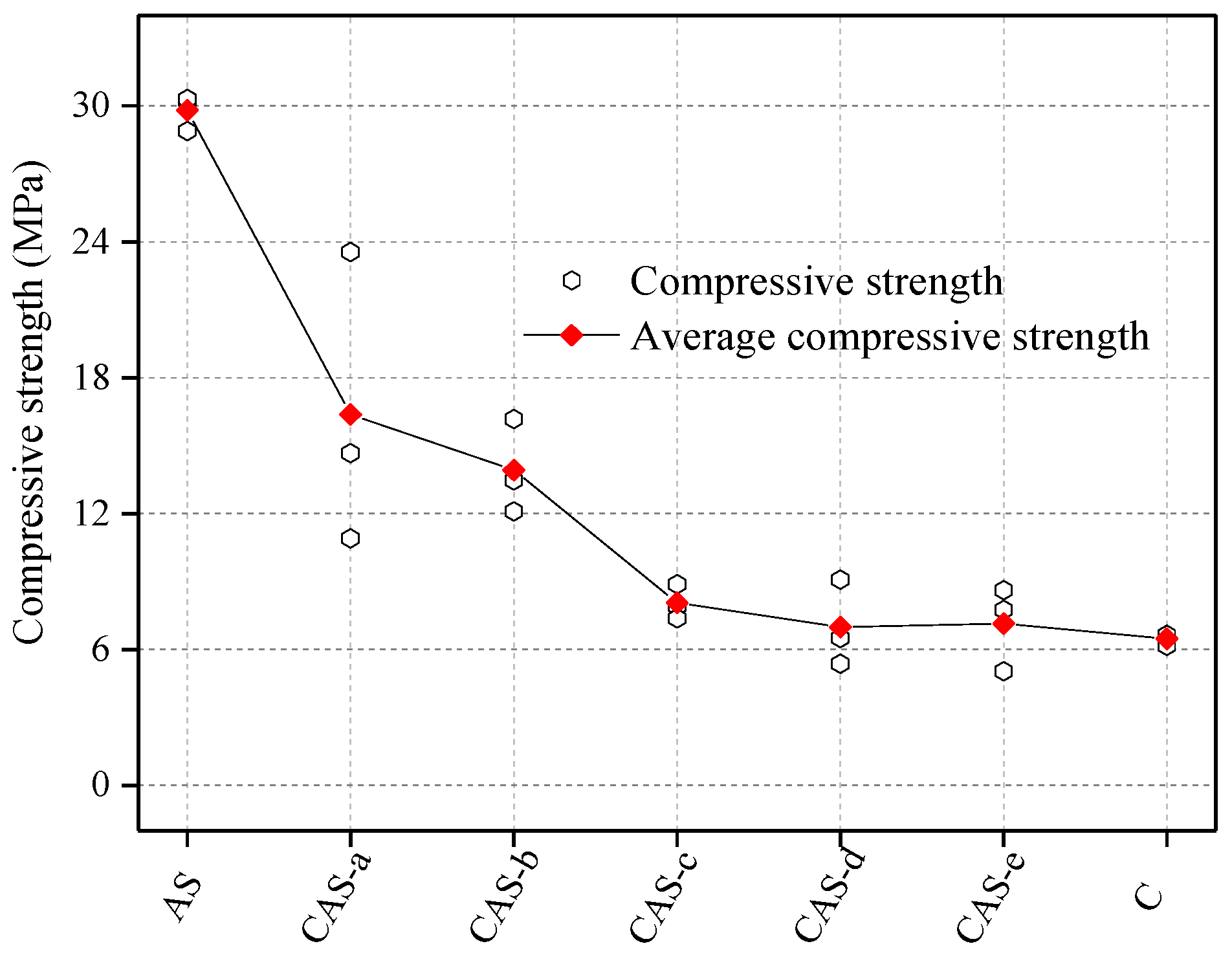

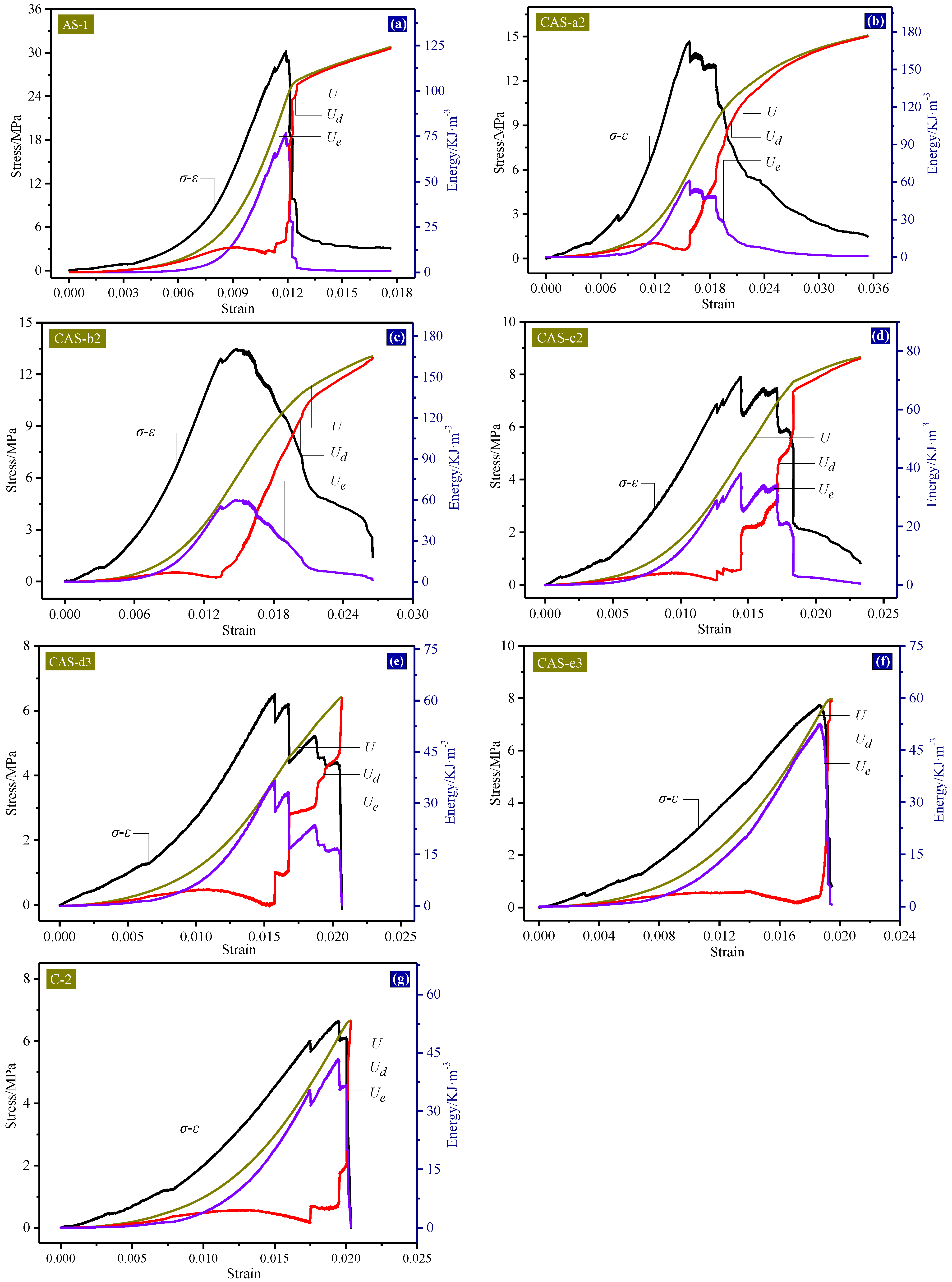
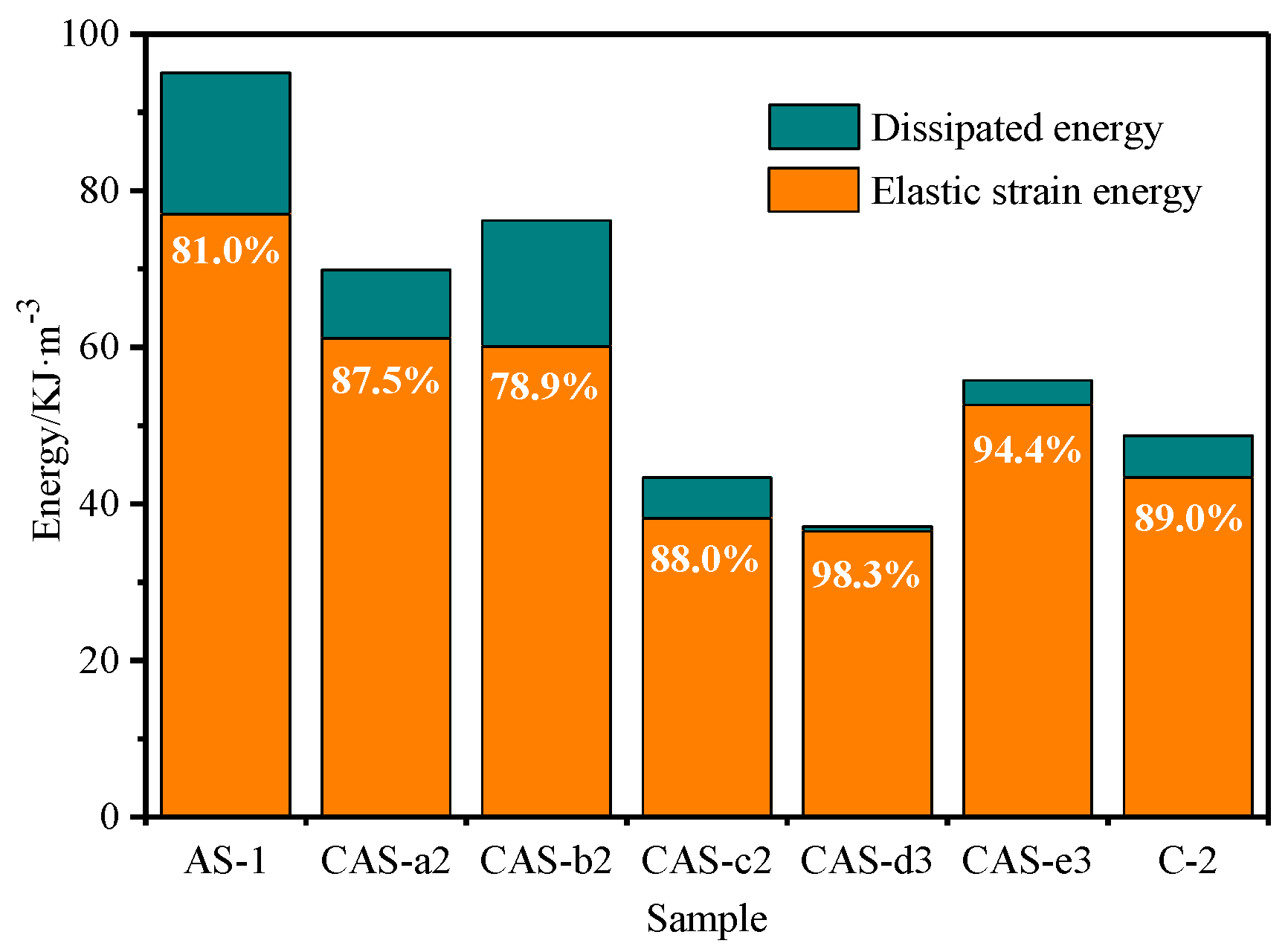


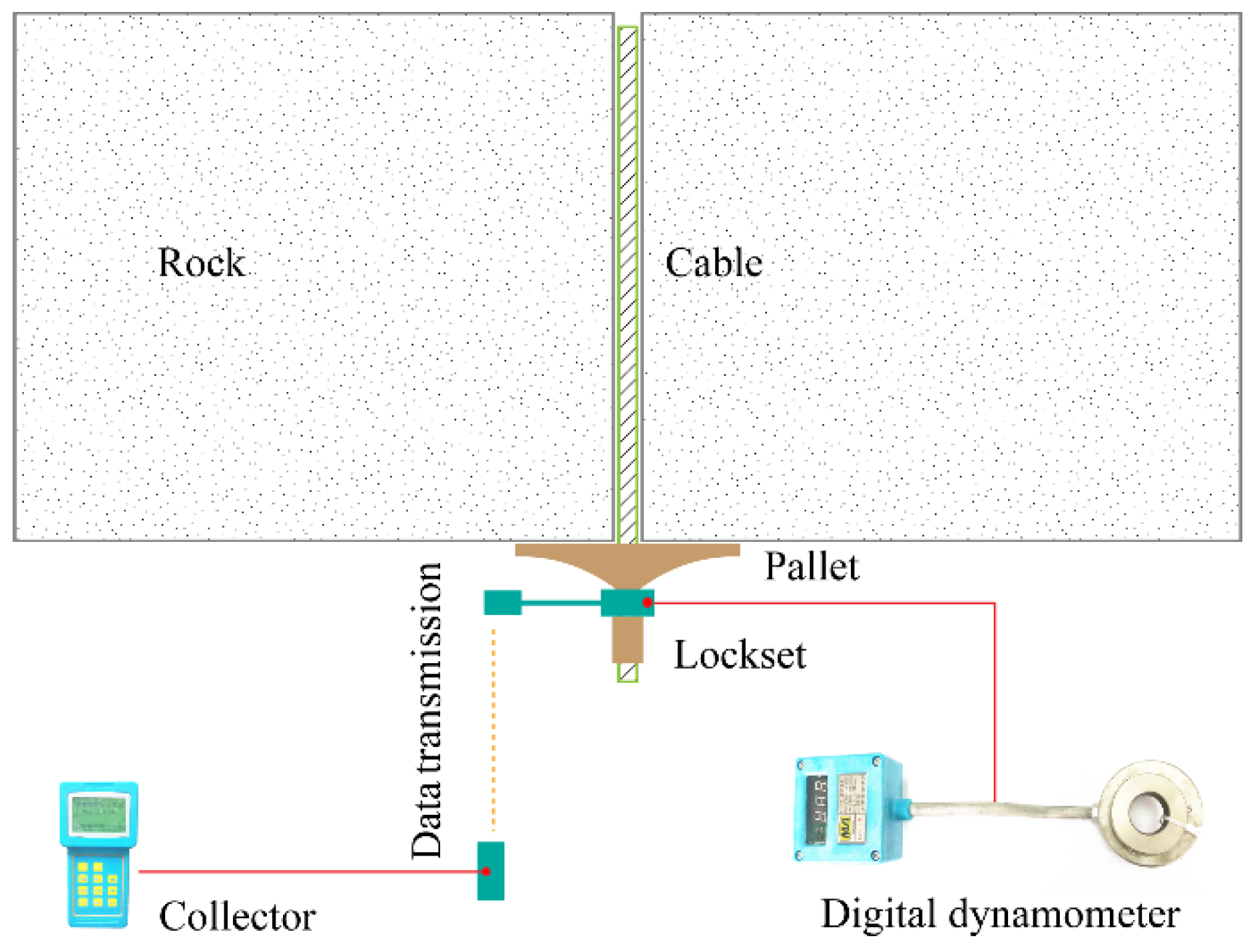
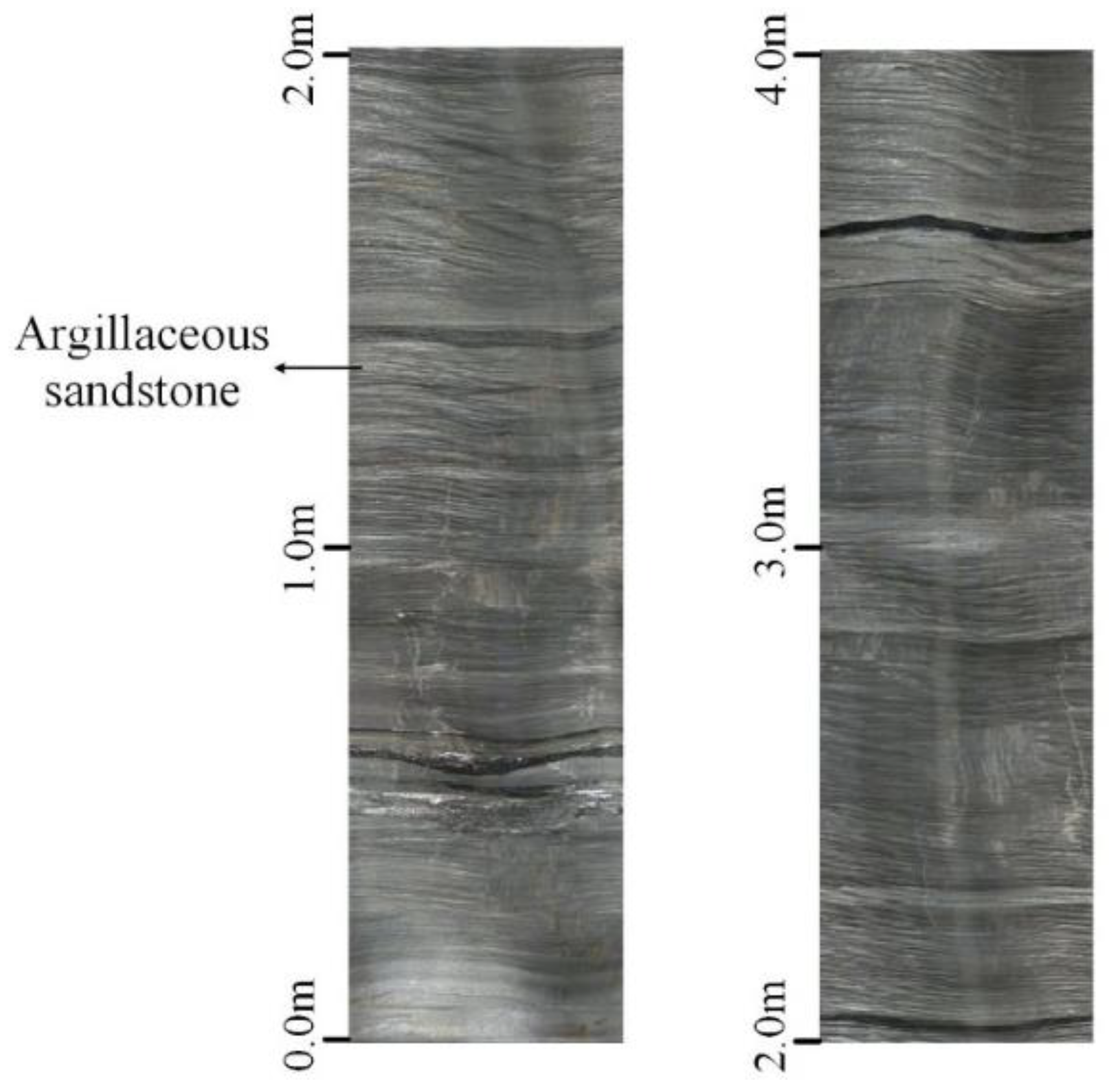
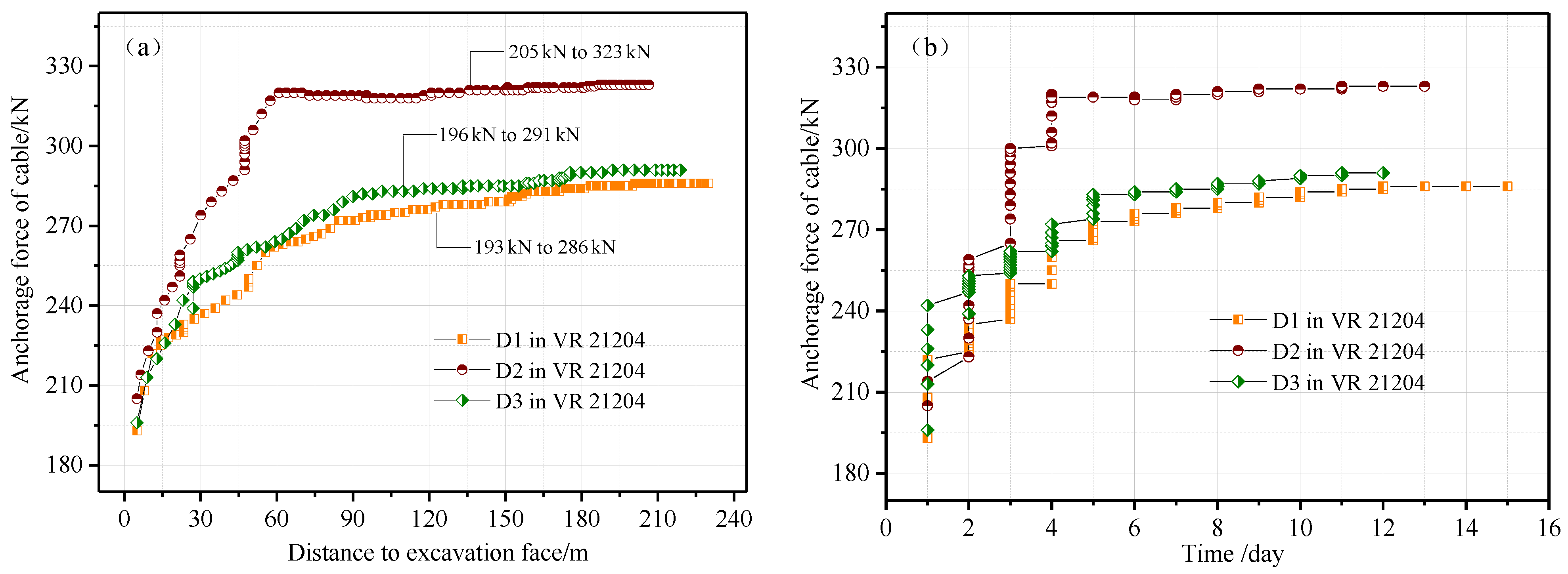
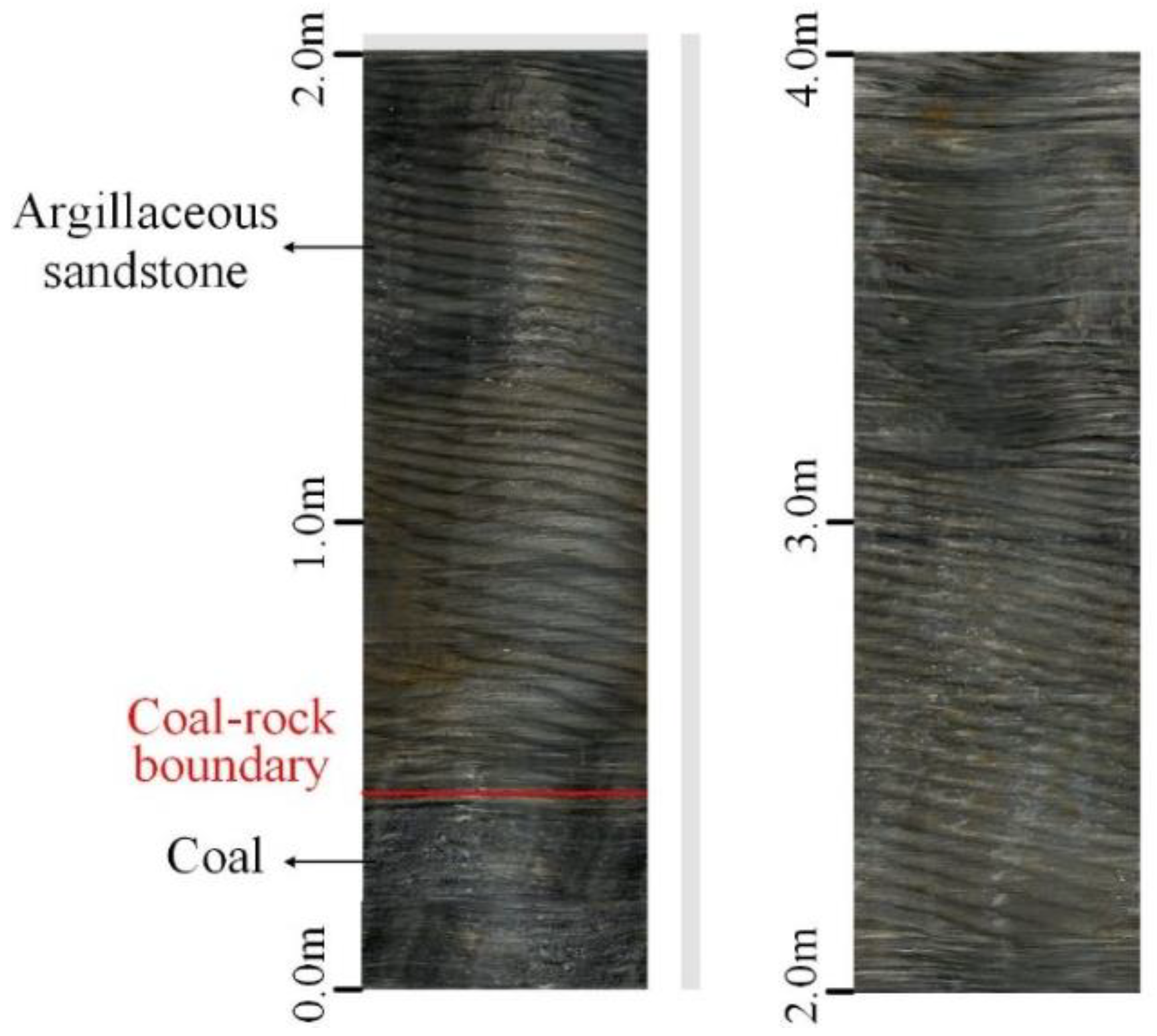
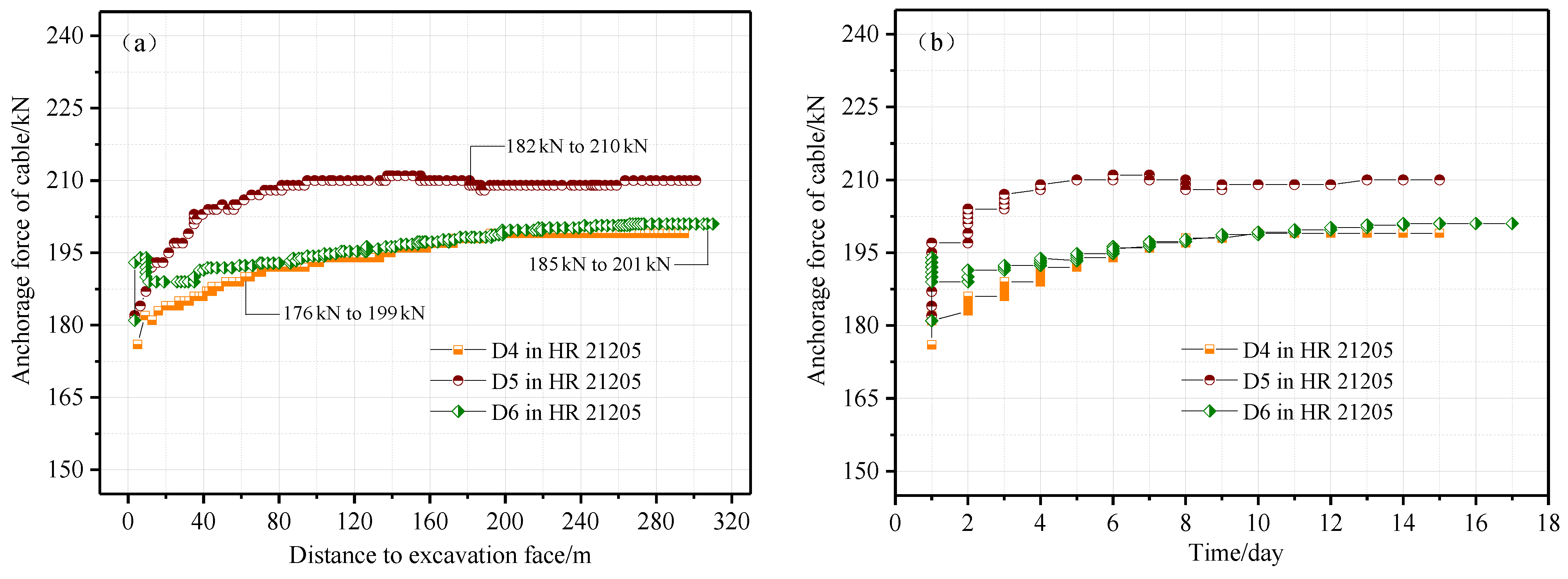
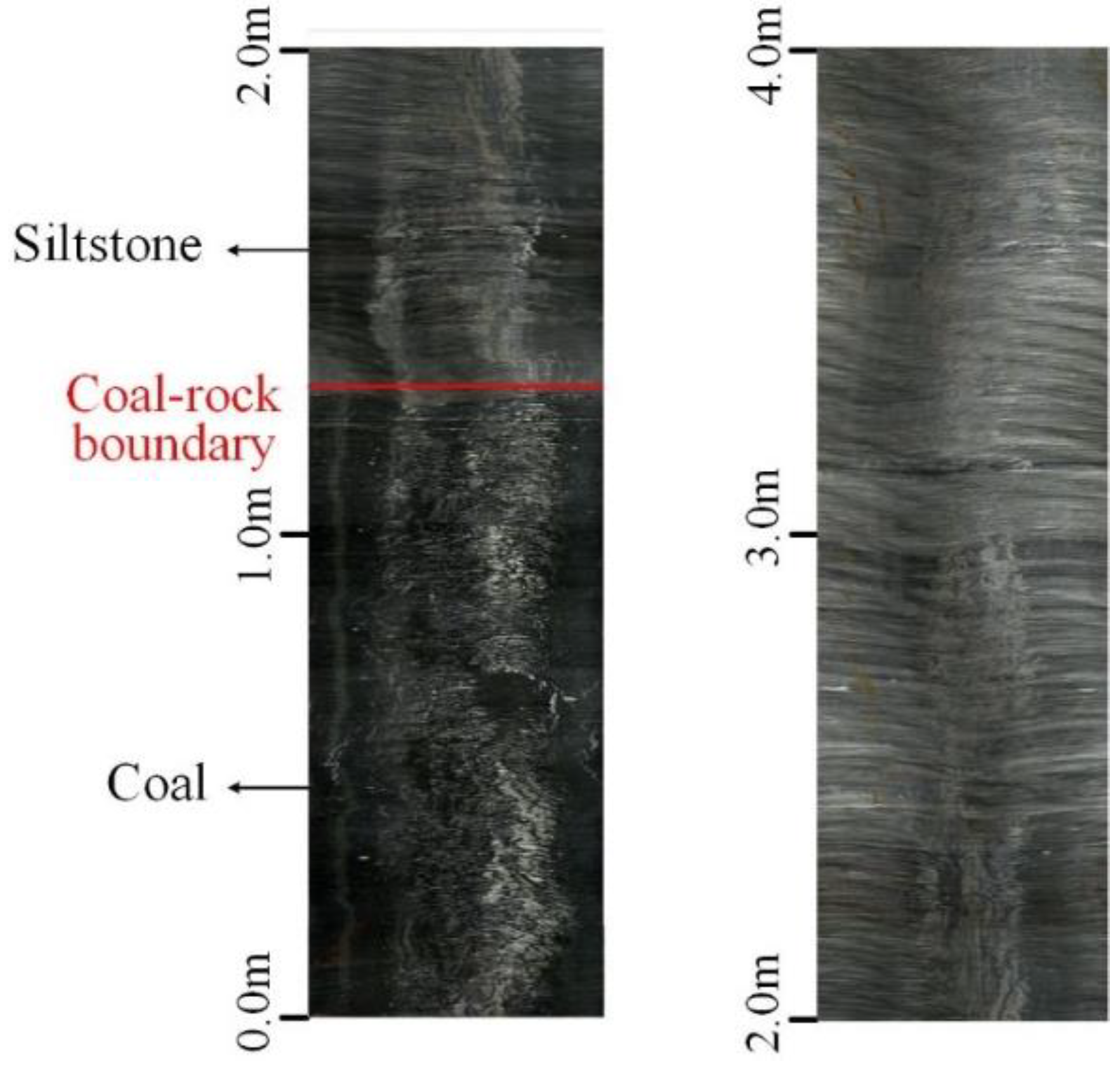
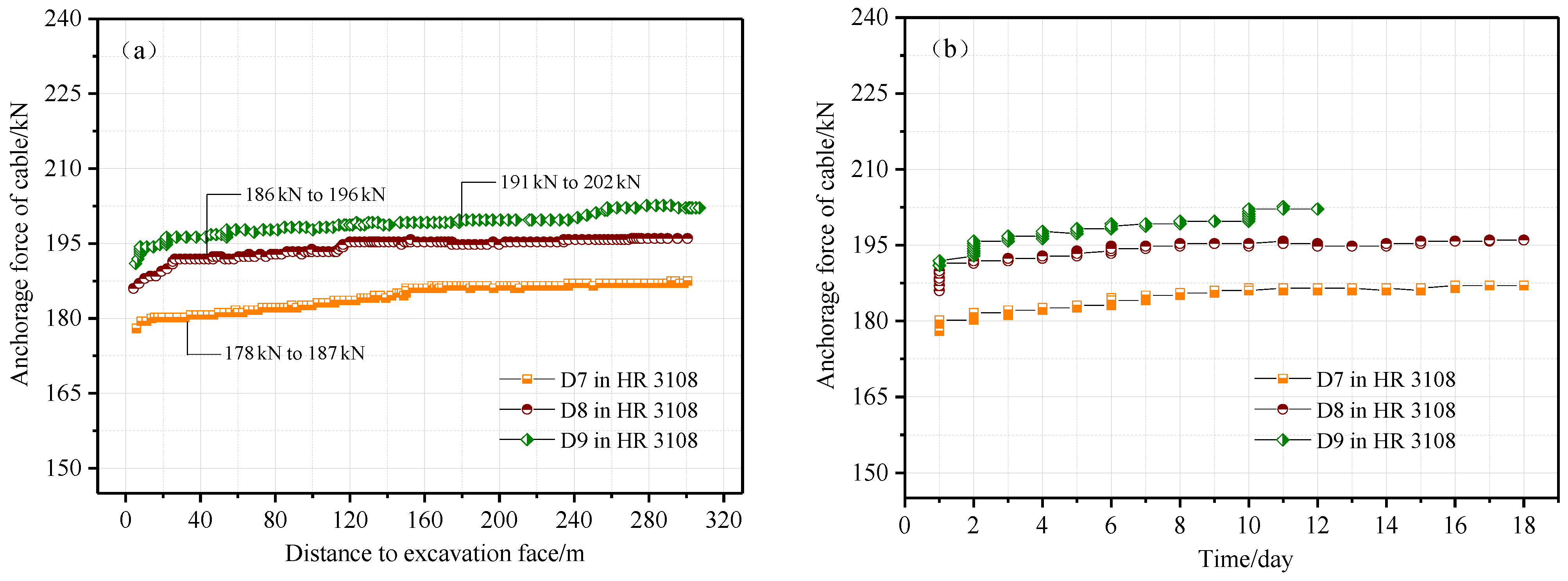
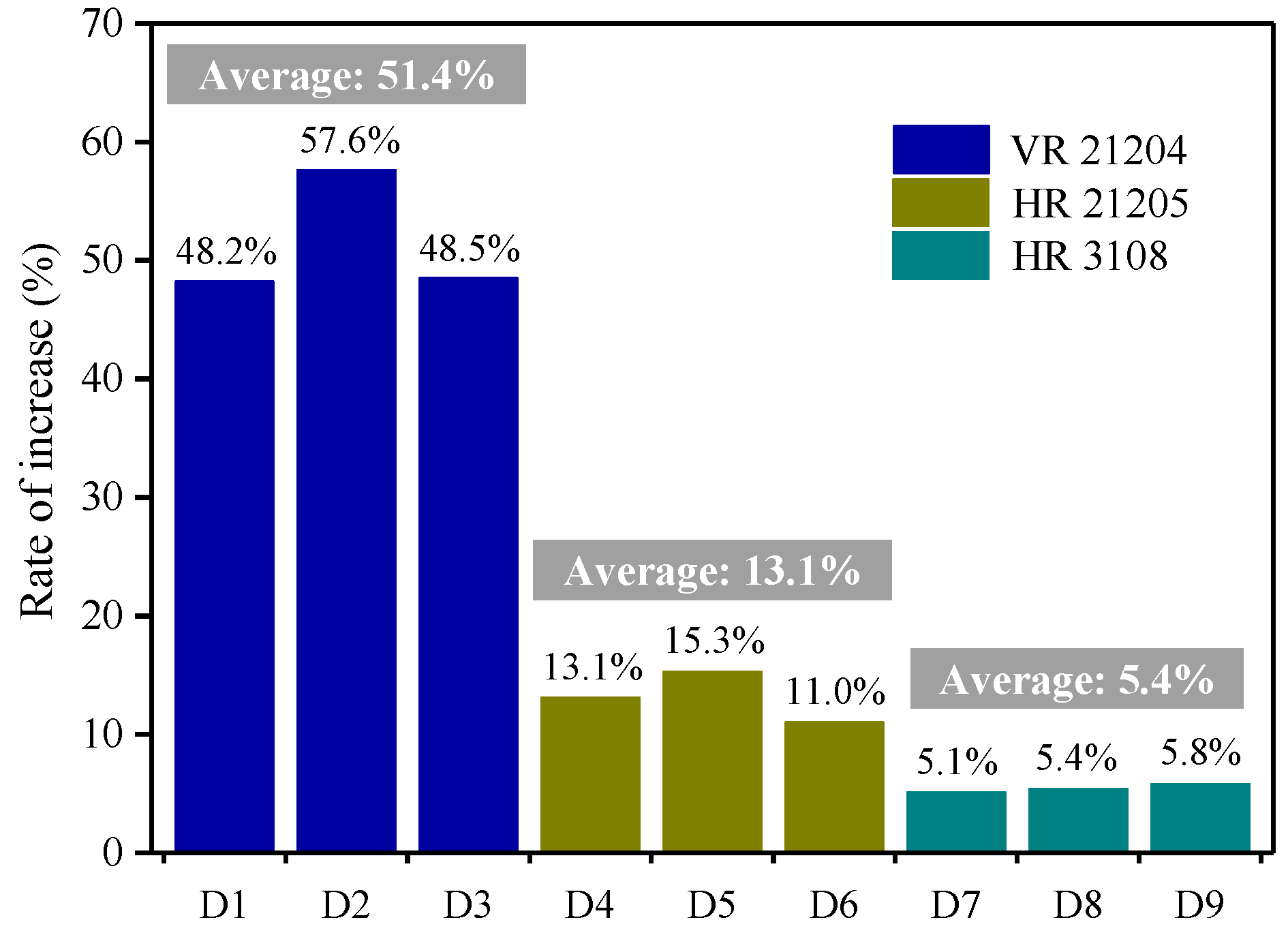
| ID | Lithology | Coal-Rock Height Ratio | Coal Height/mm | Rock Height/mm | Number |
|---|---|---|---|---|---|
| AS | Argillaceous sandstone | 0:1 | 0 | 100 | 3 |
| CAS-a | Coal-argillaceous sandstone structure | 1:7 | 12.5 | 87.5 | 3 |
| CAS-b | 1:3 | 25 | 75 | 3 | |
| CAS-c | 1:1 | 50 | 50 | 3 | |
| CAS-d | 3:1 | 75 | 25 | 3 | |
| CAS-e | 7:1 | 87.5 | 12.5 | 3 | |
| C | Coal | 1:0 | 100 | 0 | 3 |
| VR 21204 | HR 21205 | HR 3108 | |||
|---|---|---|---|---|---|
| Lithology | Thickness | Lithology | Thickness | Lithology | Thickness |
| Medium-grained sandstone | 18.2 m | Medium-grained sandstone | 13.2 m | / | / |
| Argillaceous sandstone | 2.6 m | Argillaceous sandstone | 10.7 m | Sandy mudstone | 9.4 m |
| Fine-grained sandstone | 5.3 m | Fine-grained sandstone | 5.4 m | Mid-fine grained sandstone | 19.8 m |
| Argillaceous sandstone | 3.7 m | Argillaceous sandstone | 3.5 m | Siltstone | 2.3 m |
| Coal | 3.2 m | Coal | 3.7 m | Coal | 4.8 m |
| Siltstone | 6.5 m | Siltstone | 6.8 m | Siltstone | 9.5 m |
| Argillaceous sandstone | 7.5 m | Argillaceous sandstone | 8.0 m | mid-fine grained sandstone | 21.2 m |
© 2019 by the authors. Licensee MDPI, Basel, Switzerland. This article is an open access article distributed under the terms and conditions of the Creative Commons Attribution (CC BY) license (http://creativecommons.org/licenses/by/4.0/).
Share and Cite
Xie, Z.; Zhang, N.; Yuan, Y.; Xu, G.; Wei, Q. Study on Safety Control of Composite Roof in Deep Roadway Based on Energy Balance Theory. Sustainability 2019, 11, 3688. https://doi.org/10.3390/su11133688
Xie Z, Zhang N, Yuan Y, Xu G, Wei Q. Study on Safety Control of Composite Roof in Deep Roadway Based on Energy Balance Theory. Sustainability. 2019; 11(13):3688. https://doi.org/10.3390/su11133688
Chicago/Turabian StyleXie, Zhengzheng, Nong Zhang, Yuxin Yuan, Guang Xu, and Qun Wei. 2019. "Study on Safety Control of Composite Roof in Deep Roadway Based on Energy Balance Theory" Sustainability 11, no. 13: 3688. https://doi.org/10.3390/su11133688
APA StyleXie, Z., Zhang, N., Yuan, Y., Xu, G., & Wei, Q. (2019). Study on Safety Control of Composite Roof in Deep Roadway Based on Energy Balance Theory. Sustainability, 11(13), 3688. https://doi.org/10.3390/su11133688





